Management of COVID-19 Respiratory Distress @JAMA_current: 4 most noteworthy points with some thoughts (1/9):
 https://abs.twimg.com/emoji/v2/... draggable="false" alt="1⃣" title="Keycap digit one" aria-label="Emoji: Keycap digit one">"Types L and H are the conceptual extremes of a spectrum that includes intermediate stages, in which their characteristics may overlap" https://jamanetwork.com/journals/jama/fullarticle/2765302">https://jamanetwork.com/journals/...
https://abs.twimg.com/emoji/v2/... draggable="false" alt="1⃣" title="Keycap digit one" aria-label="Emoji: Keycap digit one">"Types L and H are the conceptual extremes of a spectrum that includes intermediate stages, in which their characteristics may overlap" https://jamanetwork.com/journals/jama/fullarticle/2765302">https://jamanetwork.com/journals/...
Finally some common sense. Not much to add to this one. Thoughts by @ogi_gajic @MiscSusan @robertpdickson and @iwashyna (2/9)
Some are vehemently opposed to this ( @MGHMedicine
& #39;s FLARE). However, there might be some evidence that supports this...
PReVENT (not ARDS, nl compliance) showed  https://abs.twimg.com/emoji/v2/... draggable="false" alt="⬆️" title="Upwards arrow" aria-label="Emoji: Upwards arrow">TV (10 cc/kg) made no difference. ARMA showed
https://abs.twimg.com/emoji/v2/... draggable="false" alt="⬆️" title="Upwards arrow" aria-label="Emoji: Upwards arrow">TV (10 cc/kg) made no difference. ARMA showed  https://abs.twimg.com/emoji/v2/... draggable="false" alt="⬆️" title="Upwards arrow" aria-label="Emoji: Upwards arrow"> mortality in ARDS with TV of 6 cc/kg vs 12 cc/kg. However, no difference vs excluded pts (with mean TV of 9 cc/kg). Also
https://abs.twimg.com/emoji/v2/... draggable="false" alt="⬆️" title="Upwards arrow" aria-label="Emoji: Upwards arrow"> mortality in ARDS with TV of 6 cc/kg vs 12 cc/kg. However, no difference vs excluded pts (with mean TV of 9 cc/kg). Also  https://abs.twimg.com/emoji/v2/... draggable="false" alt="⬆️" title="Upwards arrow" aria-label="Emoji: Upwards arrow">TV seemed to BENEFIT pts w nl compliance (sub-group) (4/9)
https://abs.twimg.com/emoji/v2/... draggable="false" alt="⬆️" title="Upwards arrow" aria-label="Emoji: Upwards arrow">TV seemed to BENEFIT pts w nl compliance (sub-group) (4/9)
This doesn& #39;t mean that its always ok to ventilate normal compliance pts with 10 cc/kg. But definitely care can be individualised; If going higher than 6 cc/kg is expected to bring benefit, it should not be viewed as a magic evil threshold (5/9) https://twitter.com/phlegmfighter/status/1249343854014332936?s=20">https://twitter.com/phlegmfig...
Yes, yes, yes! Awake proning and HFNC might help avoid early intubation. Excessive inspiratory effort on the other hand could lead to P-SILI and be detrimental. Tolerate the happy patient, watch for increased EFFORT. Discussed at length previously: (7/9) https://twitter.com/ArgaizR/status/1250620308903669760?s=20">https://twitter.com/ArgaizR/s...
This is a direct criticism of APRV for "L-Phenotype". The problem lies with the definition of "recruitability". This has already been covered at length by @PulmCrit https://twitter.com/airwaycam/status/1251637700253421572?s=20">https://twitter.com/airwaycam... (9/9)

 Read on Twitter
Read on Twitter
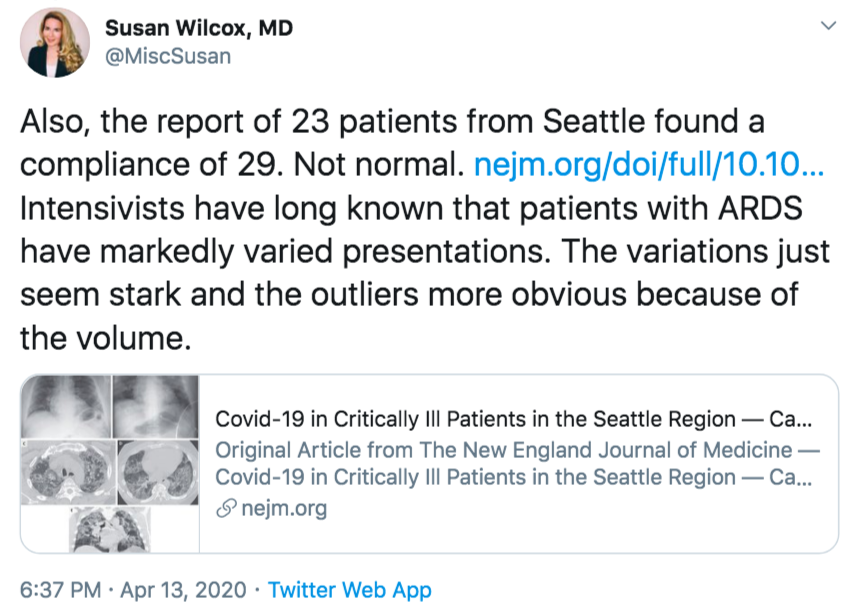
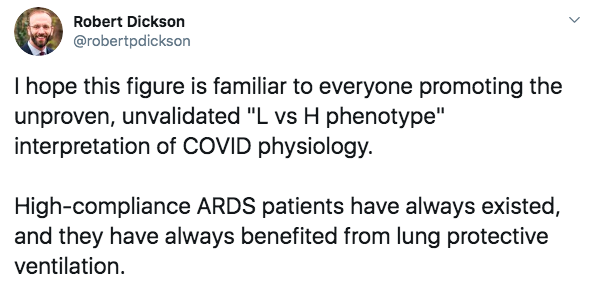
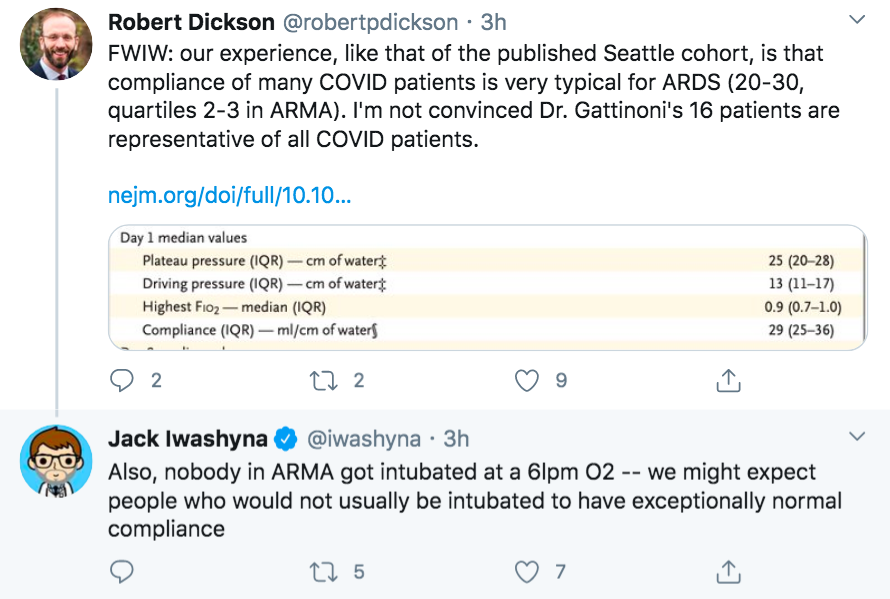
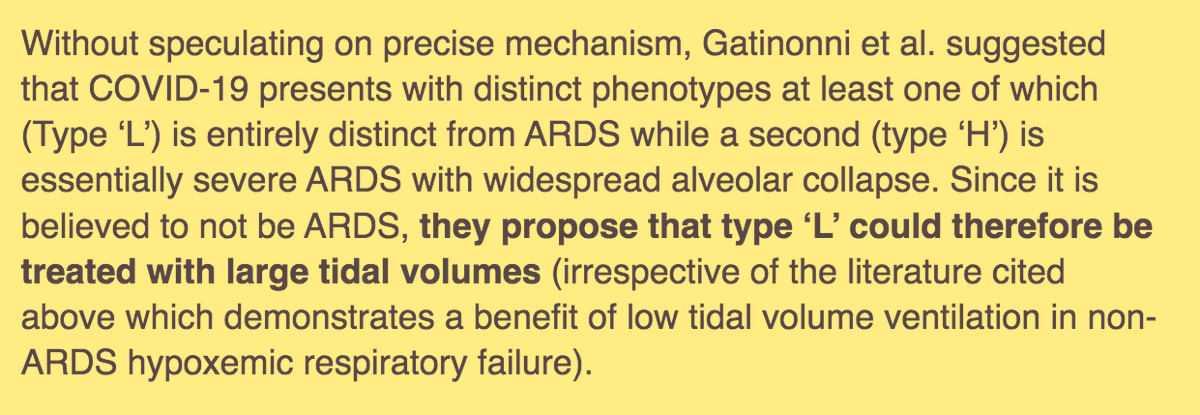 "Patients with type L, (normal compliance) accept larger tidal volumes (7-8 mL/kg IBW) without worsening the risk of VILI" Some are vehemently opposed to this ( @MGHMedicine& #39;s FLARE). However, there might be some evidence that supports this... https://abs.twimg.com/emoji/v2/... draggable="false" alt="👇" title="Down pointing backhand index" aria-label="Emoji: Down pointing backhand index"> (3/9)" title="https://abs.twimg.com/emoji/v2/... draggable="false" alt="2⃣" title="Keycap digit two" aria-label="Emoji: Keycap digit two">"Patients with type L, (normal compliance) accept larger tidal volumes (7-8 mL/kg IBW) without worsening the risk of VILI" Some are vehemently opposed to this ( @MGHMedicine& #39;s FLARE). However, there might be some evidence that supports this... https://abs.twimg.com/emoji/v2/... draggable="false" alt="👇" title="Down pointing backhand index" aria-label="Emoji: Down pointing backhand index"> (3/9)" class="img-responsive" style="max-width:100%;"/>
"Patients with type L, (normal compliance) accept larger tidal volumes (7-8 mL/kg IBW) without worsening the risk of VILI" Some are vehemently opposed to this ( @MGHMedicine& #39;s FLARE). However, there might be some evidence that supports this... https://abs.twimg.com/emoji/v2/... draggable="false" alt="👇" title="Down pointing backhand index" aria-label="Emoji: Down pointing backhand index"> (3/9)" title="https://abs.twimg.com/emoji/v2/... draggable="false" alt="2⃣" title="Keycap digit two" aria-label="Emoji: Keycap digit two">"Patients with type L, (normal compliance) accept larger tidal volumes (7-8 mL/kg IBW) without worsening the risk of VILI" Some are vehemently opposed to this ( @MGHMedicine& #39;s FLARE). However, there might be some evidence that supports this... https://abs.twimg.com/emoji/v2/... draggable="false" alt="👇" title="Down pointing backhand index" aria-label="Emoji: Down pointing backhand index"> (3/9)" class="img-responsive" style="max-width:100%;"/>
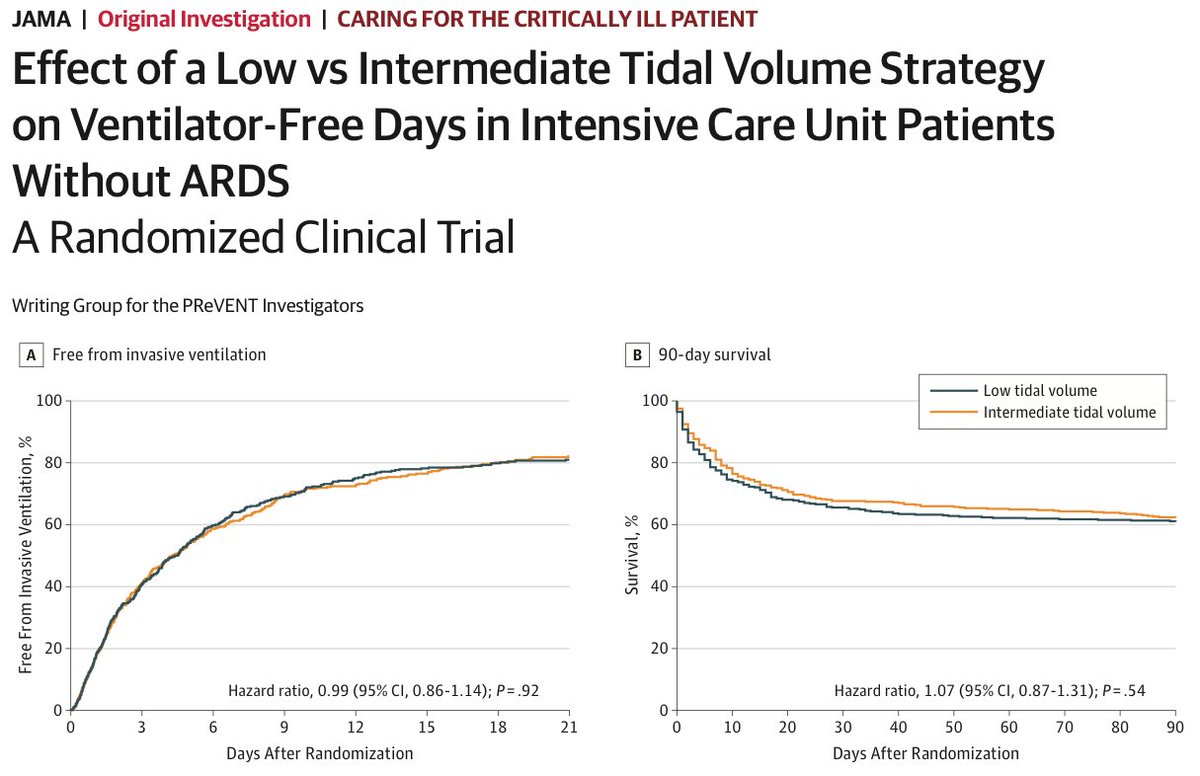 TV (10 cc/kg) made no difference. ARMA showed https://abs.twimg.com/emoji/v2/... draggable="false" alt="⬆️" title="Upwards arrow" aria-label="Emoji: Upwards arrow"> mortality in ARDS with TV of 6 cc/kg vs 12 cc/kg. However, no difference vs excluded pts (with mean TV of 9 cc/kg). Also https://abs.twimg.com/emoji/v2/... draggable="false" alt="⬆️" title="Upwards arrow" aria-label="Emoji: Upwards arrow">TV seemed to BENEFIT pts w nl compliance (sub-group) (4/9)" title="PReVENT (not ARDS, nl compliance) showed https://abs.twimg.com/emoji/v2/... draggable="false" alt="⬆️" title="Upwards arrow" aria-label="Emoji: Upwards arrow">TV (10 cc/kg) made no difference. ARMA showed https://abs.twimg.com/emoji/v2/... draggable="false" alt="⬆️" title="Upwards arrow" aria-label="Emoji: Upwards arrow"> mortality in ARDS with TV of 6 cc/kg vs 12 cc/kg. However, no difference vs excluded pts (with mean TV of 9 cc/kg). Also https://abs.twimg.com/emoji/v2/... draggable="false" alt="⬆️" title="Upwards arrow" aria-label="Emoji: Upwards arrow">TV seemed to BENEFIT pts w nl compliance (sub-group) (4/9)">
TV (10 cc/kg) made no difference. ARMA showed https://abs.twimg.com/emoji/v2/... draggable="false" alt="⬆️" title="Upwards arrow" aria-label="Emoji: Upwards arrow"> mortality in ARDS with TV of 6 cc/kg vs 12 cc/kg. However, no difference vs excluded pts (with mean TV of 9 cc/kg). Also https://abs.twimg.com/emoji/v2/... draggable="false" alt="⬆️" title="Upwards arrow" aria-label="Emoji: Upwards arrow">TV seemed to BENEFIT pts w nl compliance (sub-group) (4/9)" title="PReVENT (not ARDS, nl compliance) showed https://abs.twimg.com/emoji/v2/... draggable="false" alt="⬆️" title="Upwards arrow" aria-label="Emoji: Upwards arrow">TV (10 cc/kg) made no difference. ARMA showed https://abs.twimg.com/emoji/v2/... draggable="false" alt="⬆️" title="Upwards arrow" aria-label="Emoji: Upwards arrow"> mortality in ARDS with TV of 6 cc/kg vs 12 cc/kg. However, no difference vs excluded pts (with mean TV of 9 cc/kg). Also https://abs.twimg.com/emoji/v2/... draggable="false" alt="⬆️" title="Upwards arrow" aria-label="Emoji: Upwards arrow">TV seemed to BENEFIT pts w nl compliance (sub-group) (4/9)">
 TV (10 cc/kg) made no difference. ARMA showed https://abs.twimg.com/emoji/v2/... draggable="false" alt="⬆️" title="Upwards arrow" aria-label="Emoji: Upwards arrow"> mortality in ARDS with TV of 6 cc/kg vs 12 cc/kg. However, no difference vs excluded pts (with mean TV of 9 cc/kg). Also https://abs.twimg.com/emoji/v2/... draggable="false" alt="⬆️" title="Upwards arrow" aria-label="Emoji: Upwards arrow">TV seemed to BENEFIT pts w nl compliance (sub-group) (4/9)" title="PReVENT (not ARDS, nl compliance) showed https://abs.twimg.com/emoji/v2/... draggable="false" alt="⬆️" title="Upwards arrow" aria-label="Emoji: Upwards arrow">TV (10 cc/kg) made no difference. ARMA showed https://abs.twimg.com/emoji/v2/... draggable="false" alt="⬆️" title="Upwards arrow" aria-label="Emoji: Upwards arrow"> mortality in ARDS with TV of 6 cc/kg vs 12 cc/kg. However, no difference vs excluded pts (with mean TV of 9 cc/kg). Also https://abs.twimg.com/emoji/v2/... draggable="false" alt="⬆️" title="Upwards arrow" aria-label="Emoji: Upwards arrow">TV seemed to BENEFIT pts w nl compliance (sub-group) (4/9)">
TV (10 cc/kg) made no difference. ARMA showed https://abs.twimg.com/emoji/v2/... draggable="false" alt="⬆️" title="Upwards arrow" aria-label="Emoji: Upwards arrow"> mortality in ARDS with TV of 6 cc/kg vs 12 cc/kg. However, no difference vs excluded pts (with mean TV of 9 cc/kg). Also https://abs.twimg.com/emoji/v2/... draggable="false" alt="⬆️" title="Upwards arrow" aria-label="Emoji: Upwards arrow">TV seemed to BENEFIT pts w nl compliance (sub-group) (4/9)" title="PReVENT (not ARDS, nl compliance) showed https://abs.twimg.com/emoji/v2/... draggable="false" alt="⬆️" title="Upwards arrow" aria-label="Emoji: Upwards arrow">TV (10 cc/kg) made no difference. ARMA showed https://abs.twimg.com/emoji/v2/... draggable="false" alt="⬆️" title="Upwards arrow" aria-label="Emoji: Upwards arrow"> mortality in ARDS with TV of 6 cc/kg vs 12 cc/kg. However, no difference vs excluded pts (with mean TV of 9 cc/kg). Also https://abs.twimg.com/emoji/v2/... draggable="false" alt="⬆️" title="Upwards arrow" aria-label="Emoji: Upwards arrow">TV seemed to BENEFIT pts w nl compliance (sub-group) (4/9)">
 TV (10 cc/kg) made no difference. ARMA showed https://abs.twimg.com/emoji/v2/... draggable="false" alt="⬆️" title="Upwards arrow" aria-label="Emoji: Upwards arrow"> mortality in ARDS with TV of 6 cc/kg vs 12 cc/kg. However, no difference vs excluded pts (with mean TV of 9 cc/kg). Also https://abs.twimg.com/emoji/v2/... draggable="false" alt="⬆️" title="Upwards arrow" aria-label="Emoji: Upwards arrow">TV seemed to BENEFIT pts w nl compliance (sub-group) (4/9)" title="PReVENT (not ARDS, nl compliance) showed https://abs.twimg.com/emoji/v2/... draggable="false" alt="⬆️" title="Upwards arrow" aria-label="Emoji: Upwards arrow">TV (10 cc/kg) made no difference. ARMA showed https://abs.twimg.com/emoji/v2/... draggable="false" alt="⬆️" title="Upwards arrow" aria-label="Emoji: Upwards arrow"> mortality in ARDS with TV of 6 cc/kg vs 12 cc/kg. However, no difference vs excluded pts (with mean TV of 9 cc/kg). Also https://abs.twimg.com/emoji/v2/... draggable="false" alt="⬆️" title="Upwards arrow" aria-label="Emoji: Upwards arrow">TV seemed to BENEFIT pts w nl compliance (sub-group) (4/9)">
TV (10 cc/kg) made no difference. ARMA showed https://abs.twimg.com/emoji/v2/... draggable="false" alt="⬆️" title="Upwards arrow" aria-label="Emoji: Upwards arrow"> mortality in ARDS with TV of 6 cc/kg vs 12 cc/kg. However, no difference vs excluded pts (with mean TV of 9 cc/kg). Also https://abs.twimg.com/emoji/v2/... draggable="false" alt="⬆️" title="Upwards arrow" aria-label="Emoji: Upwards arrow">TV seemed to BENEFIT pts w nl compliance (sub-group) (4/9)" title="PReVENT (not ARDS, nl compliance) showed https://abs.twimg.com/emoji/v2/... draggable="false" alt="⬆️" title="Upwards arrow" aria-label="Emoji: Upwards arrow">TV (10 cc/kg) made no difference. ARMA showed https://abs.twimg.com/emoji/v2/... draggable="false" alt="⬆️" title="Upwards arrow" aria-label="Emoji: Upwards arrow"> mortality in ARDS with TV of 6 cc/kg vs 12 cc/kg. However, no difference vs excluded pts (with mean TV of 9 cc/kg). Also https://abs.twimg.com/emoji/v2/... draggable="false" alt="⬆️" title="Upwards arrow" aria-label="Emoji: Upwards arrow">TV seemed to BENEFIT pts w nl compliance (sub-group) (4/9)">


